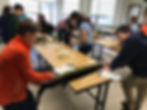Skins & Skulls Program
- Dawn Dextraze
- Jan 29, 2019
- 3 min read
I'll bring the skulls if you bring the skins! This is exactly what Dawn Dextraze, SCCD's Educator wrote to Kathleen Stowell of Lake Sunapee Protective Association (LSPA) as they were getting ready to share resources for a Mammals Skins & Skulls class last month. The skulls themselves were borrowed from Robin Tymula, a biology teacher at Stevens High School. The skins and skulls were used for multiple programs during the one week loan period.

Newport Middle's Ecology Club used them to train for the wildlife identification section of the NH Envirothon competition. Every May, teams made up of 5-6 high school or middle school students travel to Concord to test their Natural Resources knowledge in 4 subject areas: Aquatics, Wildlife, Forestry, and Soils. Each year a topic is chosen by the state for students to research and present on. In the wildlife section, students identify NH wildlife by listening to sounds, observing skins and other artifacts, and looking at pictures.

Vilas Middle 5th graders were challenged to figure out as much as they could about the ecology of the animals that the artifacts came from without naming them. They measured the length and width of the pelts and observed color, texture, smell and thickness of the fur to determine habitat type. The students observed size, teeth diversity and shape, snout length, brain size, and eye size and placement of each skull to determine the animal's place in the food chain. After they observed and recorded this information they were given wildlife info. cards that included a picture of the animal and its skull and natural history information. The students matched the cards to the skins and skulls at their station, using their observations to guide them. In this way, they were able to narrow down the options and successfully name the animals represented by the skins and skulls, while at the same time, learning more about local wildlife.


Fall Mountain high school environmental science students were asked to group the skins and skulls by families (according to the Linnaean system) based on observed similarities. A list of possible families were written on the board for them to choose from, but they had to access prior knowledge and use observation skills to determine the groups.

North Charlestown Community School 4th graders observed the thick skin of a beaver after considering strategies animals use to survive New England winters. Animals that are active during the winter may go through a period of shedding that allows them to change from a dark color to a light for winter camouflage or to change from few thin, rough hairs that allow heat to escape from the body to many thick, fluffy hairs that keep heat next to the body. Multiple layers of thick fur coupled with a fat layer just under the skin insulates animals that are active during winter.

All 4 of these programs were made possible through resource sharing. The Conservation District has its own resources lending program that includes a stream table, soil tunnel, and science kits for forest, soil, and water studies. We work with area schools and educational organizations and do our best to keep track of who has what resource, just in case, someone asks for it in the future.
For example, Goshen Conservation Commission loaned an aquarium water chiller to Lyme School this year so they can raise trout with NH Fish & Game's Trout in the Classroom program. Charlestown Middle 7th graders are also part of this program and students from the 2 schools compare learnings and plan to visit each other's release sites this spring.
The work we are able to do together is greater than what we can accomplish alone. Sharing resources, especially resources that are used for only a week out of the year, allows everyone to benefit. If you have a resource that you would like to share with Sullivan County schools or educational organizations or if you are looking for a resource, let us know. We'll keep a record of it in our "Lending Library" and contact you if we hear that someone is looking for it.

























